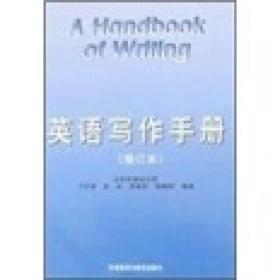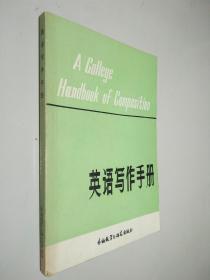
英语写作手册
①一般下午5点前订单,当日发货,开发票联系客服②教材,学习,考试类书默认有笔记(或做过)③其他类书一般无笔记,提前与客服沟通好再下单,否则本店不承担责任)④部分图书籍采用标准图片,可能存在不同印次不同封面,内容一致⑤出版时间过长的书都可能有自然发黄现象。
¥ 35.12 8.0折 ¥ 43.9 八品
仅1件
作者丁往道 等
出版社外语教学与研究出版社
ISBN9787560087863
出版时间2011-12
装帧平装
开本16开
定价43.9元
货号1509065345498465280
上书时间2024-11-18
- 在售商品 暂无
- 平均发货时间 14小时
- 好评率 暂无
- 最新上架
商品详情
- 品相描述:八品
- 商品描述
-
导语摘要
由丁往道等编著的《英语写作手册》旨在为非英语专业的学生提供一些实用的英文写作技巧。全书分十章,对文体格式,遣词造句、整篇作文,论文和书信,简历等的写作都做了详尽的阐述。它既用中文讲解,又保留了英语例句和范文,从而会使读者受益匪浅;这样的写作训练是全面的训练,不仅有助于提高语言水平,还有助于提高观察分析、逻辑思考的能力,有助于培养严谨的工作作风,这无疑对我国的英语教学工作是一大推进。
目录
致教师
致学习者
Part One Manuscript Form
致教师
致学习者
I.Arrangement
II.Capitalization
III.W10rd Division
IV.Punctuation
V Handwriting
I.Levels of Wlords
II.The Meaning Of W.Ords
III.General and Specific W10rds
IV.Idioms
V Figures of Speech
Part Two Diction
1.Simile
2.Metaphor
3.Personification
4.Metonymy
5.Synecdoche
6.Euphemism
7.Irony
8.Overstatement and Understatemem
9.Transferred Epithet
10.Oxymoron
11.Alliteration
VI.Dictionaries
1.Using Dictionaries
2.Some Good Dictionaries
Part Three The Sentence
Ⅰ.Complete Sentences and Sentence Fragments
II.Types of Sentences
1.Declarative,Interrogative,Imperative,and Exclamatory Sentences
2.Simple,Compound,Complex,and Compound-Complex Sentences
3.Loose.Periodic。and Balanced Sentences
4.Short and Long Sentences
III.Efiective Sentences
1.Unity
2.Coherence
3.C:onciseness
4.Emphasis
5.Vafiety
Part Four The Paragraph
I.Criteria of an Efiective Paragraph
1.Unity
2.Coherence
3.Transition
II.Steps in Writing a Paragraph
III.Ways ofDeveloping Paragraphs
1.Development by Time
2.Development by Process
3.Development by Space
4.Development by Example or Generalization
5.Development by Comparison and Contrast
6.Development by Cause and Effect
7.Development by Classification
8.Development by Definition
9.Development by a Combination of Methods
Part Five The Whole Composition
I.Criteria of a Good Composition
II.Steps in Writing a Composition
1.Planning a Composition
2.Writing the First Draft
3.Revising the First Draft
4.Making the Final Copy
III.Three Main PaNs of a Composition
1.The Beginning
2.The Middle
3.The End
……
Part Six The Summary and Book Report
Part Seven Formal and Informal Styles
Part Eight The Research Paper
Part Nine Practical Writing
Part ten Punctuation
批改/校对符号
写作错误统计表
内容摘要
《英语写作手册(英文版)(第3版)》讲述了:“新经典”高等高校英语专业系列教材根据《高等学校英语专业英语教学大纲》,并结合英语专业教学的*新发展而编写,包括英语语言技能、英语专业知识和专业知识三个类别,涵盖高校英语专业本料至研究生各阶段、各方向全要课程。本系列教材作者非常不错,内容经典,注重时代性和实用性,有助于学习者进一步提富语言技能。扩充专业知识,培养应用能力,提升综合素养。
《英语写作手册》由北京外国语大学资深专家学者根据多年的教学和研究经验精心编写而成,自1984年推出以来,深受读者欢迎,多次重印,如今印数已超过百万册,并分别于1994年和1997年推出了修订版和中文版。《英语写作手册》(第三版)由原作者倾力修订,保留原书经典内容,并根据时代特点进行适度更新;新增了练习和参考答案,进一步强化学练并重的教学要求,是高校英语专业和非英语专业写作课程的优选教材。④系统全面:从文稿格式、选词、造句到篇章、论文、应用文,循序渐进、面面俱到,引导学生在系统学习中融会贯通④内容丰富:讲解深入浅出,范例典型实用,练习针对性强,附有学生范文,方便比较学习④讲练结合:理论与实践并重,课上练习、课下作业、参考答案紧密结合、环环相扣,帮助学生在实际运用中稳步提升“英语写作手册》(修订本)曾获全国高校第三届很好教材一等奖
相关推荐
— 没有更多了 —


















以下为对购买帮助不大的评价